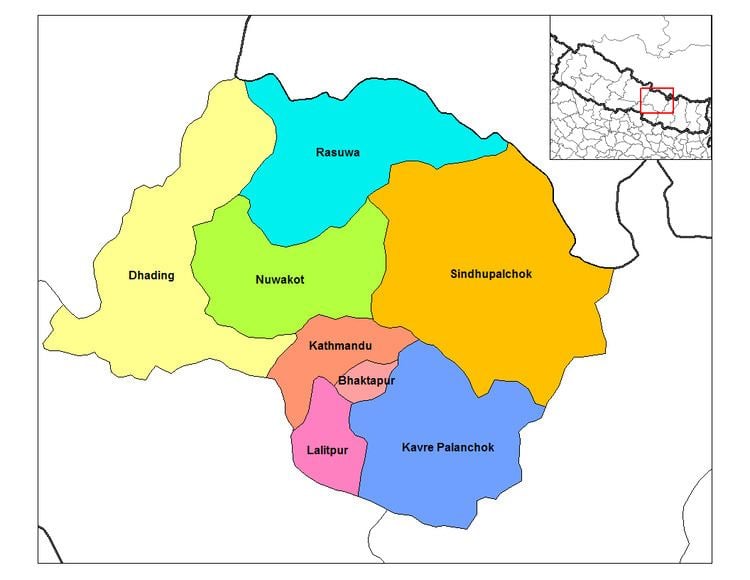Headquarters Kathmandu Main language(s) Nepal BhasaNepali Area 395 km² Destinations Kathmandu, Nagarkot | Region Central Time zone NPT (UTC+5:45) Website Official website Zone Bagmati Zone | |
 | ||
Points of interest Colleges and Universities Tribhuvan University, Institute of Medicine - Nepal, Kathmandu Medical College, Nepal Medical College, St Xavier's College - Maitighar | ||
Kathmandu District (Nepali: काठमाडौं जिल्ला Listen ; Nepal Bhasa: येँ जिल्ला) is a district located in Kathmandu Valley, Province No. 3 of Nepal, a landlocked country in South Asia. It is one of the 75 districts of Nepal, covers an area of 395 km2 (153 sq mi), and is the most densely populated district of Nepal with 1,081,845 inhabitants in 2001 and 1,744,240 in 2011. The district's headquarters is Kathmandu Metropolitan City, also the capital of Nepal. It is also a famous tourist spot as there are many religious temples, places.
Contents
- Map of Kathmandu Nepal
- Geography
- Geography and Climate
- Culture
- Economy
- Education
- Administration
- Demographics
- Hospitals
- References
Map of Kathmandu, Nepal
Geography
Kathmandu district is one of the three districts located in Kathmandu Valley, which itself is located in the hills of Bagmati Zone, Central Development Region, Nepal. The district is located from 27°27′E to 27°49′E longitude and 85°10′N to 85°32′N latitude.
The district is surrounded by:
The altitude of the district ranges from 1,262 m (4,140 ft) to 2,732 m (8,963 ft) above sea level.
Geography and Climate
In the urban center, the temperature fluctuates between 32 °C in summer (June–July) to -2 °C in winter (December–January). The annual rainfall of the district is 176.4 ml.
Culture
Kathmandu district is a part of Kathmandu valley, which is a melting pot of various cultural groups, ethnicities, races, languages and religions. This vibrant culture is illustrated in the culture of the natives of the district, known as Newars, who are a multiethnic, multiracial, multireligious people bound by a Sanskritized Sino-Tibetan language of Kirat origins known as Nepal Bhasa. All the ancient settlements of the district have specific street festivals (jatras) arranged according to specific dates of the Nepal Sambat calendar. The main festivals celebrated are:
Along with these festivals, with the influx of population from other parts of Nepal, India, Tibet and South Asia, other festivals such as Teej, Chhath, Sakela, Lhosar, Janai Purnima, Deuda etc. are also celebrated.
Economy
Most of the offices and industry of Nepal are in Kathmandu. The major economic hubs are New Road, Durbar Marg, Putalisadak, Asan. The district exports handicrafts, artworks, garments, pashmina, paper etc. Tourism is one of the main industries of the district. Hindu and Buddhist pilgrims from all over the world visit various religious places located in the district such as Pashupatinath, Swayambhunath, Boudhanath, Buddhanilkantha etc. Freak Street and Thamel are noted tourist destinations for Western tourists.
Education
Kathmandu district is the pioneer district in education in many aspects in Nepal. Durbar High School (the first school of Nepal), Trichandra College (the first college of Nepal), Padma Kanya College (the first women's college) are all located in Kathmandu city. Tribhuwan University, the first university of Nepal, is located in Kirtipur municipality of Kathmandu district. Besides these, thousands of educational institutions are located in the district which cater students from Nepal, India, Bangladesh etc.
Administration
The district consists of 11 Municipalities. These are as follows:
Demographics
The total population of the district is 1,744,240 out of which 913,001 are male and 831,239 female in 436,355 households. Average family size was 4.6 in 2001 and 4.0 in 2011
